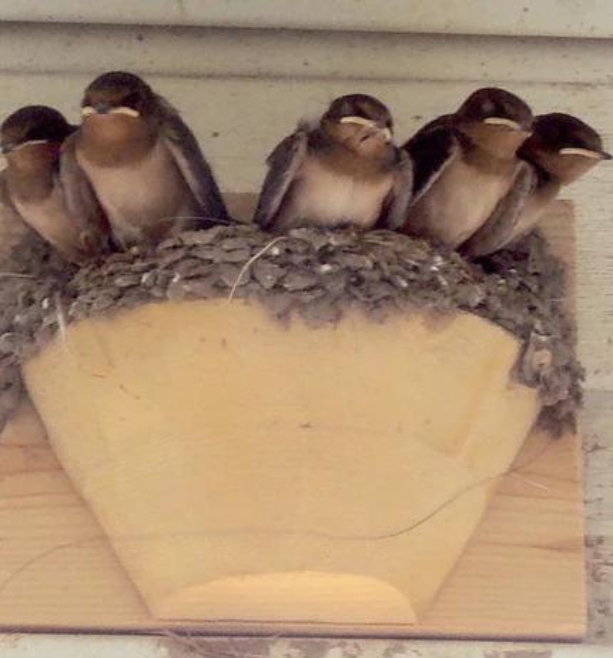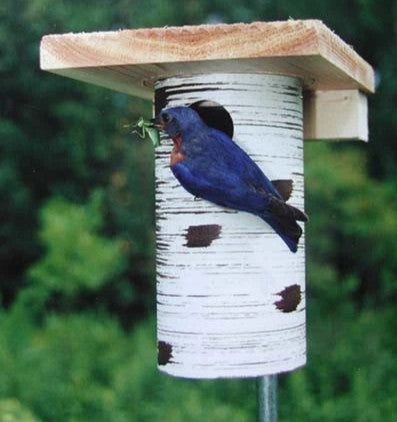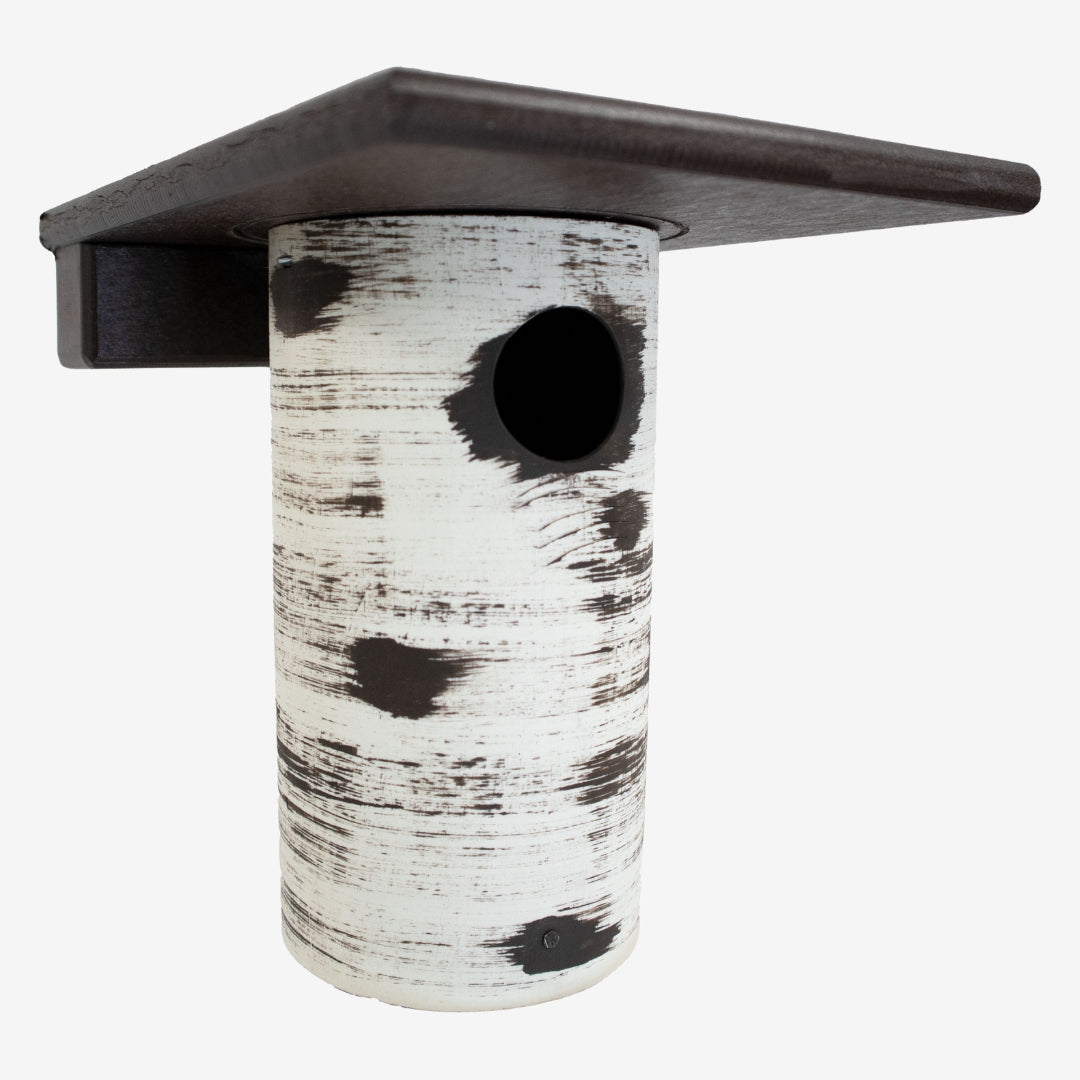Providing bluebird houses has long been a favorite pastime in North America. Bluebirds are loved for their beautiful color, as well as their gentle disposition and pleasing song. A symbol of love and happiness, their family bond compares to no other songbird.
A Massive Effort to Save Blues
 Once a common bird, the bluebird was numerous even in urban residential areas, but has seen a drastic decline in numbers with the Eastern Bluebird losing up to 90 percent of its population in the early 70s.
Once a common bird, the bluebird was numerous even in urban residential areas, but has seen a drastic decline in numbers with the Eastern Bluebird losing up to 90 percent of its population in the early 70s.
Several factors, such as insecticide use, the destruction of habitat, predators, and competition from non-native birds have all contributed to their decline.
First and foremost... it is the invasive house sparrow who has caused their peril. A non-native bird, house sparrows are public enemy number one for bluebirds.
Those with a passion for bluebirds have begun a massive effort to save blues through the erection of thousands of appropriate nest boxes and trail habitats. And the rebound is on as bluebirds are re-appearing (and being monitored) in areas where the trails have been established.
Bluebird Species
There are three species of bluebird, all belonging to the thrush family:
- Eastern Bluebird
- Western Bluebird
- Mountain Bluebird

Eastern Bluebird
|
Mountain Bluebird |
Western Bluebird |
The Eastern Bluebird (Sialia sialis) breeds in every state east of the Rocky Mountains. It is bright blue with a rusty red breast similar to the robin.
The Western Bluebird (Sialia currucoides) breeds in the western states from Canada to Mexico and east to Colorado. It has a blue throat, and the red color extends to its upper back.
The Mountain Bluebird (Sialia mexicana) breeds in the Northwest, east to the Dakotas, and north into Alaska. It is entirely blue, with a white underbelly.
Bluebirds are primarily insectivores, eating many insects considered pests by humans: cutworms, grasshoppers, and flying insects. They supplement this diet in fall and winter with wild berries and may starve if snow covers the ground and berries are unavailable. You can greatly help bluebirds in your yard by offering suet and mealworms.
 Bluebird Spring Courtship Rites
Bluebird Spring Courtship Rites
The spring courtship rites of the bluebird are among the most enjoyable to witness. The male selects a suitable nesting cavity and devotes all his energy to luring a female to it with song and his "wing-tip" dance. He sings and sings, as the female sits passively by enjoying his effort.
When she inspects the nesting place, he interprets her interest as acceptance and his song becomes even more passionate. But the final selection of the nest site is hers, and if she finds his choice unacceptable, he must search for something more suitable.
The female builds a nest of dry grass or pine needles and other plant material, most commonly pine straw. The nest is typically about three to four inches deep.
Here the Eastern Bluebird lays an average of three to five clear blue eggs (though occasionally they may be white), with the Western and Mountain species adding one or two more. They hatch in two weeks and the baby birds leave the nest in approximately 20 days, ready to fly and learn about the world.
Raising Baby Bluebirds
Unable to feed themselves, parents will coax them to feeders in just a few short weeks. By fall the pair has likely raised two or three clutches of young and may migrate south if their food supply (native berries and insects) runs out or if it just gets too cold. Supplemental feeding and heated bird baths may just keep them around through winter depending on your locale.
Bluebird Chief Competitors
The bluebird's chief competitors among other birds are the House Sparrow (or English Sparrow) and the European Starling, both of which like the same type of nesting space. Sparrows will destroy bluebird eggs in a nest, or move into the nest during the winter when the bluebird has migrated.
They will even peck baby and/or adult birds to death, with bluebirds often unable to defend themselves. Starlings will drive bluebirds out of an entire area and occupy every available nesting cavity... unless man intervenes. This is legal for non-native birds!
What Can We Do?
 We can entice bluebirds by providing suitable habitats, winter shelter, and food supplies. Plants that bear berries in spring or fall (bittersweet, hackberry, dogwood, American holly, privet, bayberry, sumac, and others) will provide food for not only bluebirds but many other avian friends.
We can entice bluebirds by providing suitable habitats, winter shelter, and food supplies. Plants that bear berries in spring or fall (bittersweet, hackberry, dogwood, American holly, privet, bayberry, sumac, and others) will provide food for not only bluebirds but many other avian friends.
Winter roost boxes provide shelter in the coldest season for many birds. In areas where bluebirds find sufficient food, they may stay all year, but a roost box will allow them warmth on cold nights.
And specially designed bluebird houses, feature predator guards on the entrance to keep out squirrels, raccoons, and competing birds will give the bluebird a safe place to live and rear its young.
Squirrel baffles are also ideal once a nest has been established. Nests of sparrows and other competitors must be cleaned out of the bluebird house on a regular basis.
What is a "Bluebird Trail?"
People sometimes create a "bluebird trail" by hanging many bluebird houses in an area, about 100 yards apart, to give the bluebirds an abundance of housing. They are often placed on fence posts, giving the appearance of a "trail."
Tree swallows often find bluebird houses to their liking as well, and this problem can be lessened by hanging two houses back to back, even on a post or close to each other.
Two bluebirds will not nest near each other, so this gives the swallows one house and the bluebirds the other. The swallows will even help protect the bluebirds from other competing birds.
For troubleshooting tips and more detailed information with answers on everything bluebird-related, please visit Sialis.org. It's a wonderful wealth of knowledge on bluebirds and other NA native cavity nesting birds.











